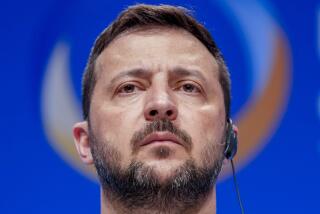Leningrad Is Window on Europe for Soviets
- Share via
LENINGRAD, Soviet Union — It’s cold and wet in Leningrad. We’re at the Hotel Pribaltiyskaya on the Gulf of Finland. There’s a steady drizzle but no wind. Suddenly, a gale comes off the gulf, strong enough to blow you to Moscow.
Sunset never comes. It gets darkest about 1:30 in the morning. There is always a silver glow in the northern sky.
The hotel is Leningrad’s newest and biggest, with 1,200 rooms, four bars, four restaurants, a nightclub, a bowling alley and a gymnasium.
On each floor is a coffee shop open till 2 a.m. A sign in the elevator reads: “It is impossible to change direction of the cab motion by pressing button indicating opposite direction.”
The bartender in the all-night Business Bar sells Beck’s beer for one U.S. dollar. I said: “How come some hotel bars deal in dollars, others in rubles?”
He said: “Is all Russian business. I understand little English. I understand beer, vodka, women--and dollars.”
The Intourist office is strictly organized, with 10 desks. Each has a lamp with a sign: “Train tickets,” “Theater tickets,” “Special services.”
There is a desk for lost luggage, one for medical aid, another for restaurant reservations.
The woman at the “Individual Tourist” desk said: “Pick up your passport at the Key Desk. Pick up your airline ticket at the Flight Desk. Reserve your transport to the airport at the Car Desk.”
Olga, our guide, is very nervous if everyone is not five minutes early. “Is bad. Very bad. The weather is not fine, so we will not walk.”
Lunch in Leningrad comes from delicatessens; heavyset women butchers chop sausage and bacon. They wear white caps and gowns.
Tell the woman at the cash register what you want. She gives you a receipt to hand to the butcher. You wait in line for both transactions.
I wound up with a brick of cheddar cheese and a foot of bologna. Bought a soda at a street stand and sat on a park bench near the Hermitage.
The Hermitage is why we come to Leningrad. The museum was built in 1754 as a winter palace for the czars. The guides spout startling statistics.
“There are 2.5 million exhibits, five buildings and 120 halls of Western European art, 60 Rembrandts.”
To cover it all, you’d walk 15 miles. If you gave each painting 30 seconds, you’d see them all in 12 years.
Ceilings are high enough for kite flying. Couches and chairs in purple velvet are scattered about for resting between hikes. They have hand-carved armrests, painted gold.
A guide is absolutely necessary. There are no directions posted in English.
Shopping is best in the dollar stores, the beriozkas . There’s one in the Hermitage. Another, next to the hotel, sells imported beer, whiskey and local vodka, fur coats, enamel jewelry and cameras--all at lower prices than we pay at home.
“It’s a waste of time shopping anywhere else,” an American woman said. She spent an hour shopping Nevski Street and found nothing she wanted.
“A man in our group bought a shirt for 14 rubles. About $16 U.S.,” she said. “Then he learned that someone with a black market connection paid $3 for the same shirt.”
Selling dollars on the black market is not a good idea. They may lock you up in the Leningrad jail and tie the key to a Russian jackrabbit.
This is Russia’s window on Europe, the second largest city in the Soviet Union, with 4.5 million people.
Its 42 islands are linked by 300 bridges, 66 rivers and canals. And 472 monuments to Lenin.
Leningrad was founded in 1703 by Peter the Great as St. Petersburg. Every czar since Peter is buried in Sts. Peter and Paul Church. The 1917 revolution began here, and here Pavlov taught his dogs to salivate cleverly at bells.
The city was known as Petrograd until 1924, when it was renamed Leningrad.
During World War II, Leningrad was under siege by the Germans for 900 days, pounded by artillery. Hitler printed invitations to a victory celebration that never came. The people of Leningrad never surrendered. “We had no food, no water, no electricity,” said the guide. “But we are a very proud people.”
More to Read
Sign up for The Wild
We’ll help you find the best places to hike, bike and run, as well as the perfect silent spots for meditation and yoga.
You may occasionally receive promotional content from the Los Angeles Times.






